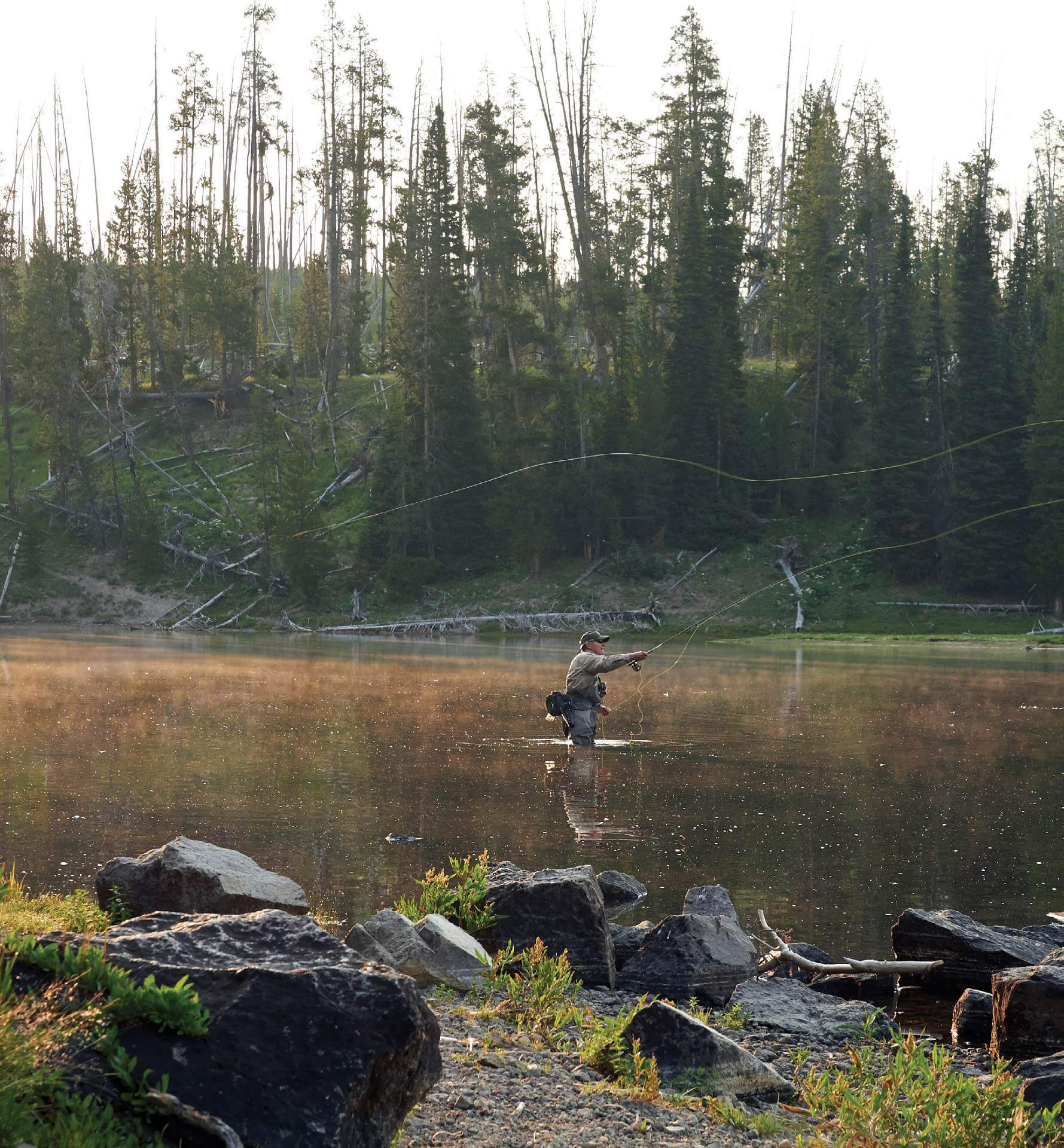
02 Feb Testing the Waters on Opening Day
I avoid crowds, rather than seek them, when fly fishing. Yet there I was, standing on the timbered, rocky banks of the Yellowstone River for the trout opener in Yellowstone National Park. After my guide, Marty Mononi, had floated me down the upper South Fork of the Shoshone River the summer before, big, beautiful Yellowstone River cutthroats appeared on my phone as text messages in what I can only describe as fish porn. He’d hooked them on opening day.
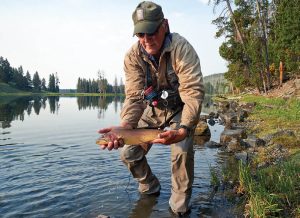
Baughman, of Cody, Wyoming, admires the first fish of the day, a handsome male Yellowstone River cutthroat.
If you asked 10 people what opening day means to them, you would probably receive 10 different answers. For me, it means major league baseball. But high on the world-famous Yellowstone plateau, it means a chance to trick a large, brilliantly colored native trout. Anglers the world over come to try their luck here. Like a trout to a caddis fly, I rose to the idea of experiencing it for myself.
Tall and loose-limbed, my pal John Baughman is the former director of Wyoming Game & Fish. A driven sportsman from Cody, he had agreed to take part, so we motored up the North Fork Highway on a smoky summer day, towing his hard-sided camper to a campground outside the park boundary. Yellowstone Park is a piece of his home water. I would quickly find that I was lost without his experience.
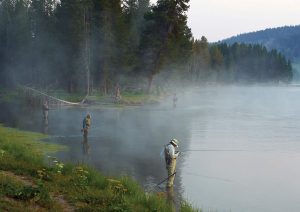
In the morning mist, several anglers compete for river space below LeHardys Rapids.
6:15 A.M.; EAST ENTRANCE. We spotted three grizzlies — a sow and her cub rewarded our early start. A boar then lumbered down a grassy hillside. I hoped it was a sign.
7 A.M.: UNNAMED PULLOUT. The pullout John favored below Fishing Bridge was unoccupied. Mist was rising from the wide, slow-moving river. Several fish rose in the film far off the shore. Striping line from the reel, John powered his back cast before hauling the line and driving it forward. His fly line shot out with a hiss and his big tandem of dry flies kissed the surface. It wasn’t long before he called out, “Fish on.” Wading out below him, I fished a dry-dropper rig. After his third fish, I wondered if I were cursed. Then, I saw the dry hesitate. I lifted, and I was tight. The fish ran downstream and I was glad for my 3X tippet. With the hook-jawed male eventually netted, I waded ashore to admire him, still displaying his brilliant spawning colors. He’d eaten my small Yellow Sally dropper.
Across the river lumbered a large bull bison headed toward the bank. Folding his knees and rolling on his back, he wallowed in a depression. Grumbling and bellowing deeply, the mighty bull waded into the river upstream and swam. Two anglers were in his path and wisely reeled up and skedaddled. A while later they reappeared, only to have the confrontation repeated with another bull.
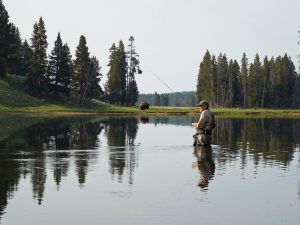
Angler John Baughman pauses, waiting for a rise, indifferent to the massive bull bison on the opposing bank.
9:45 A.M.: GRAND LOOP ROAD. There were pickups and sport utility vehicles clogging every pullout — a three-ring circus that pitted wilderness against industrial tourism. We soon lost count of the myriad license plates, some from as far as Florida and Vermont.
Below LeHardys Rapids, I noticed a large group of teenagers standing on the bank, false casting, some appearing confused, others bored. Not far below, where the river flowed close to the road, a pod of six anglers had taken stations. Engulfed in steaming mist, the bunched-up anglers appeared like some 19th century painting in the dampened light. In the forefront was an elderly woman in baggy chest waders and a floppy hat. Her jaw clenched, she cast with grim determination.
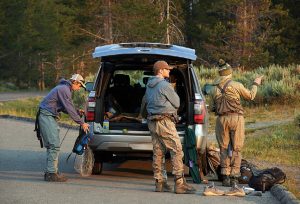
Above Sulphur Caldron, several young guides plot their strategy at a popular pullout.
10:30 A.M.: SULPHUR CALDRON PULLOUT. Above Sulphur Caldron, John pulled over. We’d covered about 6 miles and had witnessed hundreds of fishermen and -women crowding the stream. Several young anglers with the game-faced, predatory look of professional fishing guides were rigging up. John led the way through a wide, sage-filled meadow to the riverbank where I encountered Allen Branton, an aging angler who appeared to have stepped out of an Orvis catalog. Allen had been fishing the Yellowstone for the last 30 years, but this was his first opener. “It’s crowded. I expected that, but I was curious to see what the crowds would be doing. The anglers I was seeing were fishing blind in the runs, as if they were on the Madison,” he said as he ruefully shook his head. “I do a lot of looking first, seek a specific fish, and target him. The Yellowstone cutt is a pretty agreeable fish.” He ambled off upstream.
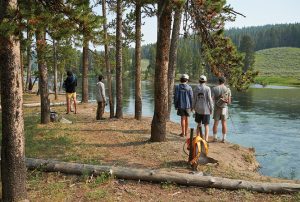
A group of teens, without guidance, seems indifferent to the allure of the river.
A steep, sagebrush-lined bank granted excellent visibility into the clear flow. We sought rising fish. There were occasional flashes of trout in the deeper runs, but no heads. Fishing the dry-dropper rig — after countless casts as I mindlessly worked upstream — it startled me when a bacon-double-cheeseburger of a trout drifted up in the water column. Instinctively, I lifted the rod and was tight. The fish bore downriver in the heavy flow as my reel protested. John waded ashore to grab the camera. After a lengthy tussle, where my fly line evaporated like I was hooked to a bonefish, I netted the bruiser in due course. His gill plates were dark red; his thick body a rich golden color stippled with small black spots. He’d gulped the dropper. John estimated the male to be 21 inches long and over 3 pounds.
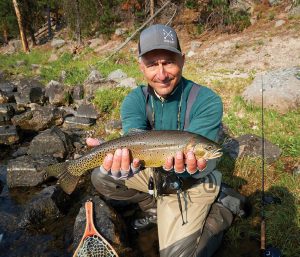
The author poses with a mature Yellowstone River cutthroat.
12:30 P.M.: NEZ PERCE FORD PICNIC AREA. Over 30 vehicles jammed the dusty lot. We found the last parking space. Wading anglers littered the Yellowstone like businessmen in downtown Denver at lunch hour. A picnic table with several anglers drew my attention. Behind the table was a line of six pickups, all backed in, where a large group of anglers were hanging out like they were tailgating at a football game.
Dean Levin, a bearded young L.A.-based artist, expertly sautéed seasoned, hand-cut lamb chops in olive oil on a portable gas grill. Acknowledged for creating “process-based, design-driven, highly architectural work,” Levin is “almost famous” according to The New York Observer. He was hanging with Kyle Yanagihara, who has spent time in the art world in New York. Kyle’s mother, Leslie McCarter Smith, was enjoying the scene from a camp chair with her angler husband, Rob Smith, who splits time between California and their ranch in Whitehall, Montana. Out on the banks of the river, the perfectly prepared lamb was improbable. There were several more pals making up their groovy, skilled fish posse. For many anglers, the opener had become a tradition. For this distinctive crew, the opener had the feeling of a ritual.
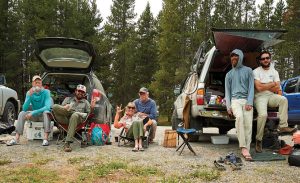
A fish posse of pals from around the country takes a welcome lunch break at Nez Perce Picnic Area. (Pictured from left to right: Dylan Varner, Colin McElroy, Leslie McCarter Smith, Rob Smith, Kyle Yanagihara, and Dean Levin)
I asked Rob what opening day meant to him, and he directly replied, “Bird hunting in Malta, Montana. I’ve got four bird dogs. It’s like Christmas morning.” When I broached the same question to Kyle, he grinned and said, “It’s here, on the Yellowstone. It’s like New Year’s Eve, the Fourth of July, and Christmas all rolled into one.”
4:00 P.M.: UNNAMED PULLOUT. We circled back to where we had started. The pullout was choked with vehicles. A visibly stressed-out woman sat stranded with her three kids in a compact car. Another woman sat in a camp chair reading a book in front of a truck hitched to a large travel trailer — long-suffering fishermen’s wives. I didn’t envy the mother of three.
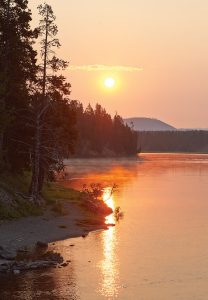
A smoky sunrise greets us just below Fishing Bridge, on the bank of the Yellowstone River.
An angler was casting in our spot. The angler, who hailed from West Virginia, hooked and landed a strong fish. I coaxed up a hit by skittering the fly, only to lose him. A young angler had been throwing dries downstream. He waded ashore and moved above us. The family, who’d been cooped up in the compact, came down to see how Dad was faring. Their oldest child, a boy of about 11, waded out deeply into the river as if he were at the beach, followed by his 8-year-old sister. Dad tried to fish, but gave up and reeled in. “Dad,” the girl who was out in the chilly water up to her chest called out, “can I pee in the river?” He affirmed. Several minutes later, she called out again: “Dad, can I poop?” “No!” he barked. It was time to head for camp.
8 A.M.: THE FOLLOWING DAY. There were 90 percent fewer anglers. It was as if we were on another river. We noodled around to survey the stream. Down at Nez Perce Ford Picnic Area, the previously packed parking lot was empty. We returned to the pullout above Sulphur Cauldron and hiked down to the river. A large herd of bison grazed downstream and we could see several swimming across the river.
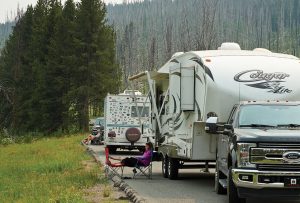
A bored wife from West Virginia, reading a paperback, awaits her angler husband at a river pullout.
In the sharp morning air, I gazed out at the vapor trails of Mud Geyser as they appeared like large plumes of campfire smoke. The multi-hued river bottom was pristine. Bellowing bison sounded like huge pigs belly grunting. The acrid smell of sulfur filled my nostrils. Where else, I thought, but the crown jewel of America’s national parks could one’s senses be vitalized by such a timelessly wild setting? Herons flapped overhead as ravens croaked, their cries echoing off the hillsides. It filled me with wonder.
After the day’s previous beating, the fish had lockjaw, so we moved. Back at the truck, John noticed a large, dark animal running through the meadow. “It’s an adult grizzly,” he said. The bruin covered ground like a thoroughbred. Once the bear got to the river, it ran downstream to cross at a wide riffle not 30 yards from where I’d been casting. Had we not moved, I might have had an unpleasant encounter.
NOON: THREE MILE CAMPGROUND. During the drive back down Shoshone Canyon, I felt a restored sense of contentment. While it had been the first day and the trout unpressured, they weren’t exactly Hollywood starlets — easy or many. The opener had been far more than simple metrics. Yet, something about the fishing felt off; when I returned home, I reached out to several authorities to investigate. David Sweet, who spent over a decade helping to bring the Yellowstone cutthroat back from near extinction, had this to say: “Before the illegal introduction of lake trout, the cutthroat population in Yellowstone Lake was over 3.5 million fish. By the early 2000s, the population had crashed to between 200,000 and 400,000 fish. Through systematic gillnetting, the lake trout population has been winnowed, resulting in an encouraging comeback in cutthroat trout. The battle is ongoing, and it’s going to continue to be expensive.”
Such complexities dwarfed my egocentric desire to catch “the big one.” I dearly hoped the fishery would continue to improve in the foreseeable future. Our experience heartened John, who is an expert in his own right. He felt the fishery was trending in the right direction. So much for Marty’s fish porn.




No Comments